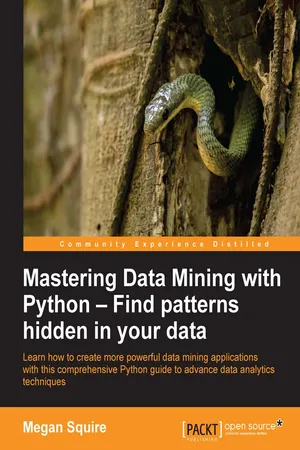
- 268 pages
- English
- ePUB (mobile friendly)
- Available on iOS & Android
Mastering Data Mining with Python – Find patterns hidden in your data
About this book
Learn how to create more powerful data mining applications with this comprehensive Python guide to advance data analytics techniques
About This Book
- Dive deeper into data mining with Python – don't be complacent, sharpen your skills!
- From the most common elements of data mining to cutting-edge techniques, we've got you covered for any data-related challenge
- Become a more fluent and confident Python data-analyst, in full control of its extensive range of libraries
Who This Book Is For
This book is for data scientists who are already familiar with some basic data mining techniques such as SQL and machine learning, and who are comfortable with Python. If you are ready to learn some more advanced techniques in data mining in order to become a data mining expert, this is the book for you!
What You Will Learn
- Explore techniques for finding frequent itemsets and association rules in large data sets
- Learn identification methods for entity matches across many different types of data
- Identify the basics of network mining and how to apply it to real-world data sets
- Discover methods for detecting the sentiment of text and for locating named entities in text
- Observe multiple techniques for automatically extracting summaries and generating topic models for text
- See how to use data mining to fix data anomalies and how to use machine learning to identify outliers in a data set
In Detail
Data mining is an integral part of the data science pipeline. It is the foundation of any successful data-driven strategy – without it, you'll never be able to uncover truly transformative insights. Since data is vital to just about every modern organization, it is worth taking the next step to unlock even greater value and more meaningful understanding.
If you already know the fundamentals of data mining with Python, you are now ready to experiment with more interesting, advanced data analytics techniques using Python's easy-to-use interface and extensive range of libraries.
In this book, you'll go deeper into many often overlooked areas of data mining, including association rule mining, entity matching, network mining, sentiment analysis, named entity recognition, text summarization, topic modeling, and anomaly detection. For each data mining technique, we'll review the state-of-the-art and current best practices before comparing a wide variety of strategies for solving each problem. We will then implement example solutions using real-world data from the domain of software engineering, and we will spend time learning how to understand and interpret the results we get.
By the end of this book, you will have solid experience implementing some of the most interesting and relevant data mining techniques available today, and you will have achieved a greater fluency in the important field of Python data analytics.
Style and approach
This book will teach you the intricacies in applying data mining using real-world scenarios and will act as a very practical solution to your data mining needs.
Frequently asked questions
- Essential is ideal for learners and professionals who enjoy exploring a wide range of subjects. Access the Essential Library with 800,000+ trusted titles and best-sellers across business, personal growth, and the humanities. Includes unlimited reading time and Standard Read Aloud voice.
- Complete: Perfect for advanced learners and researchers needing full, unrestricted access. Unlock 1.4M+ books across hundreds of subjects, including academic and specialized titles. The Complete Plan also includes advanced features like Premium Read Aloud and Research Assistant.
Please note we cannot support devices running on iOS 13 and Android 7 or earlier. Learn more about using the app.
Information
Mastering Data Mining with Python – Find patterns hidden in your data
Table of Contents
Mastering Data Mining with Python – Find patterns hidden in your data
Table of contents
- Mastering Data Mining with Python – Find patterns hidden in your data